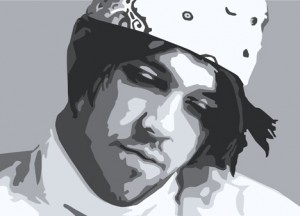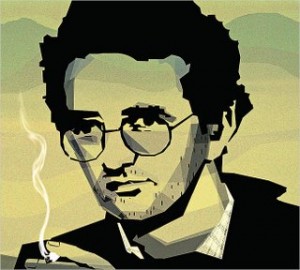A Letter About Bolaño
A new friend in another country emailed me the following. The subject line was 2666: “There is this group of authors that mostly perplex me, from whom I end up reading more books than from anyone else, not really knowing why, Dostoievsky and Kafka were representative, now Bolaño. I never had the chance to hear someone who would have loved/been obsessed by one of these authors tell me about his or her relationship with them. May I ask you to tell me more about what you found (find still I guess) in this book?”
My response:
X,
You’ve pointed out a vital, strange fact: some readers feel enthralled to the work of certain authors. This opaque compulsion happens with a handful of authors in a given reader’s lifetime, I believe. It’s as if the enthralled reader cannot afford to give out more of their secret cravings. That to do so would be to risk revealing one’s most vaporous secret.
I’ve read a lot of Bolaño’s work, but I can’t say that I love my time inside his books. They hold for me this strange magnetism, to which you’ve alluded. When I think about the mechanics of Bolaño’s work, and the peculiar atmosphere of nearly all his novels, I often go blank. When I talk about his work with friends, I lean too heavily on metaphor and analogy. I’m either unwilling or unable to face the trace of his work directly, avoiding the center of 2666, or The Third Reich. Is the center of Bolaño’s work too dark to articulate explicitly? Some novels feel like elaborate shields around terror. Though, no: Bolaño’s novels don’t feel like they’re surrounding an evil in order to allude to it while also protecting their visitors, us readers.
To me, 2666 is a document that traces a dark channel of energy. This energy is constituted simply: it is life’s cannibalism of itself. This flow is dark because it lacks exuberance. Power expresses itself in Bolaño’s novels in muteness, or in insinuated terms. Bolaño’s evil whispers, whispers because its weapons have already been buried. 2666, ostensibly a long novel about navigating a world of obsessive violence and mental compulsion, is stylistically tame. Its darkness permeates the stratum just under the surface of its lingual foundation, its simple sentences which sometimes loop around and through psychological agonies—or which sometimes document budding cruelties. Bolaño’s realms are steeped in the sinister. Violence is explicit, but often merely as artifact. We see replica after replica of evil, shorn up in gutters and dumpsters and ditches.
Bolaño’s characters are, as a rule, reduced to confusion, and eventually to a despondency leaden with fate. The characters who catch glimmers off of life’s underground river are often made to disappear. The naive die. The poor, as well. The few who know never know directly; their obliqueness to the truth assures their living, even their becoming mythological. His books are not afraid to present the staggering violence hidden in simple conversations. For Bolaño, the novel is an apparatus for calmly vivisecting our attempts to clothe life in civilization.
As documents of the labor of a mind, Bolaño’s books testify to the great range of creative desire. Hundreds of poems, many novellas, excruciating novels. Bolaño’s work forms a fugue. I think its melody is most strongly stated in 2666, and most precisely stated in The Third Reich. The former novel is open-eyed, openly haunted, and presents the blunt violence of modern life in a cold starlight. The latter novel is precise, figural, listless, claustrophobic, lodging you in a hunting ground conveniently labelled Resort. 2666 invests you in a world in which death and madness are quiet, profane, and assured; The Third Reich invests you in a world in which death and madness are simple moves in a blind and silent game. Though I don’t see Bolaño’s subtle fatalism as equivalent with Kafka’s. Bolaño’s fatalism could only be considered a byproduct of humanity’s hollow pageantry, like a ceaseless laugh in an empty theater. Bolaño’s fatalism feels cosmic, gnomic. The fate spoken by his work has the walled glance of a predator.
But I’ve leaned too heavily on metaphor and analogy. I’ve again avoided facing the center. But what if this is precisely why we find ourselves drawn in to Bolaño’s work? Maybe we find ourselves drawn in to his work because of the astounding fact of its hidden center. Most writers can no longer afford subtlety; Bolaño’s work testifies to the low, rumbling power of a writer unafraid to stare past the world.
Yours,
K
25 Points: The Unknown University
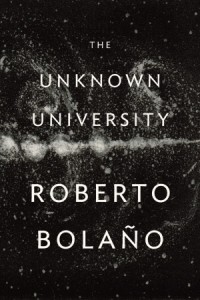 The Unknown University
The Unknown University
by Roberto Bolaño
New Directions, 2013
766 pages / $39.95 buy from Amazon
1. I’ve a strange attachment to Roberto Bolaño. One of coincidence and timing and love.
2. The Savage Detectives came out in the US six years ago, the same week I decided that—yeah, dammit—I was going to do an MFA.
3. I finished my MFA not too long ago (May-ish), just as the Bolaño Library seems to have exhausted its basement of posthumous manuscripts with The Unknown University, “a deluxe, bilingual edition of all the poems of the great Roberto Bolaño.” (Or so says the flap).
4. The Unknown University, really, reads more as a manuscript of notebooks. Poems incorporate drawings, caesuras become page-breaks, forms change again and again and again. At first, it reminded me of Jack Kerouac’s Mexico City Blues, in which every page of the book was in fact a typed page of a notebook’s musings. This feels like that, but rewritten from notebooks to computer and revised.
5. It’s 700+ pages and irresistible to a Bolañophile like me. A short story that recently ran in the New Yorker appears (“Mexican Manifesto”), as does the whole of the novel Antwerp, albeit in somewhat different form (and under the title “People Walking Away”). I didn’t do a full index-to-index comparison, but it also seems the whole of 2008’s The Romantic Dogs appears in a scattering throughout Part Three.
6. Despite these inclusions, though, The Unknown University isn’t a collection of previously-published books, like other “complete” collections can tend to be. (Just above my Bolaño shelf at home are the Collected Lydia Davis and Amy Hempel, which are exactly that).
7. Some such collections, like Jack Gilbert’s or Richard Hugo’s, have a section of “uncollected” pieces that follow the chronological reprintings. The Unknown University is sort of like one big “uncollected” section, but one that the author took the time to fashion into something that can live alone.
8. According to the note from the heirs: “The present edition corresponds exactly to the manuscript we found (with only a few minimal corrections taken off of his computer). Roberto himself dates it to 1993.”
9. These are early writings. An author’s note lists the completion of some sections as early as the 1970’s, when Bolaño was just Roberto, one of the boy-poet idealists he takes so often as subject in his fiction. In several poems he makes reference to his age (typically 26 or 27), which would have been around 1979-80.
10. One could imagine The Unknown University as the texts Bolaño wrote during the time of his writerly maturation, for what many now is the MFA. READ MORE >
August 22nd, 2013 / 11:00 am
25 Points: Antwerp
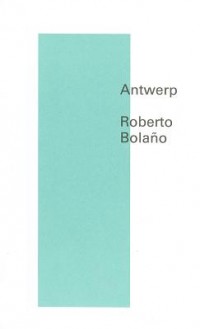 Antwerp
Antwerp
by Roberto Bolaño
New Directions, 2012
96 pages / $9.95 buy from Amazon
1. I wouldn’t say that this is the big bang of Bolaño’s fictional universe. I would say that it’s a baby fictional universe growing in the black hole of another baby fictional universe growing in the black hole of another baby fictional universe growing in the black hole.
2. This book has a lot of quotations without identified speakers. Without particularized mouths. As in how do we know who’s speaking or what it means to claim possession of a speech act. As in how do we know what’s Tupac and what’s a hologram of Tupac.
3. It’s like if I were to say to my computer, “say banana” and it said “banana,” and if this went on for a while with me saying words and my computer repeating them, until eventually I wrote down only my computer’s part of the exchange and made a novella out of it. Except that instead of saying banana I would say things like
“ The evening light dismantles our sense of the wind.”
4. Machines that move you. People in cars and trains, racing across highways and fields, going nowhere fast, towards a multiplicity of voided horizons.
5. Once I had a dream that was also a film I was directing where the main character kept experiencing acute disassociation from her body every time she got on an airplane or into a car, etc, and in the dream I (as the director and actress of the film) kept feeling the words “I’m not here.” I wish I could describe the torture of that feeling besides just calling it singular and unforgettable. Similar to the feeling of watching the movie Inception in the middle seat of an airplane flying over the ocean. Also, the feeling of reading this book, in certain moments.
6. There’s someone writing a story, the one you’re reading, and as the words are being written they’re simultaneously being picked up and examined by the characters in the story, or they’re splattering onto the car windshield of the man driving across the desert, who every few minutes catches himself looking down at his wrist despite the fact that he’s never worn a watch, not once in his life. i.e. “The word ‘teeth’ slid across the glass, many times.” Its pretty much how I feel about being human and having to die- like I have the vaguest awareness of myself as a decaying thing, but only enough to be a minor irritation to whomever(s) or whatever(s) may or may not have put me here.
7. One really great thing is how many of the short, one page “chapters” are actually scenes from the avant-garde porn film Bolaño wanted to make but never did. Or maybe he wanted someone else to read the book and do it for him. He even gave clues as to what he imagined the premiere would look like: a hunchback in the forest watching while someone ties a sheet to a pine tree with a thick piece of yellow cord and then says, smiling, “I’m going to show a film.”
8. This is one of those literary works that make me wish I’d studied quantum physics as a kid instead of making timelines.
9. At one point someone diagrams the changes in the affective landscape of a dream using straight-wavy-jagged line patterns and follows that with “nnnnnnnn” repeated, which is a really estranging onomatopoeia because I don’t seem to belong to the sound-world it’s referencing.
10. There’s a character who’s just called “the hunchback.” I’m not going to be corny and say that this was my favorite character in the book, except that I’m not sure there are any other characters. READ MORE >
April 4th, 2013 / 5:00 pm
25 Points: Woes of the True Policeman
 Woes of the True Policeman
Woes of the True Policeman
by Roberto Bolaño
Farrar, Straus and Giroux, 2012
256 pages / $25.00 buy from Amazon
1. I don’t want to believe this is a draft of works that were to come later.
2. And yet its opening section appears word-for-word in The Savage Detectives.
3. I’ve read over and over that Bolaño worked on this book from the 1980s up to his death in 2003. The endnote (which comes abruptly) suggests he was serious enough about it to have revised a couple of times by hand, on an electric typewriter, and on a computer. There were also two physical manuscript versions. Parts of all of these were pieced together to create this book. This corresponds with other accounts of trying to bring his posthumous work into order. I remember reading somewhere that he first wrote the name “Arcimboldi” in the late 1980s.
4. Reading that distressed me. All I could think about on the way to work later, looking at the sidewalk, was whether whoever wrote that had meant “Arcimboldi” or “Archimboldi.”
5. In 2666, we get the life story of Benno von Archimboldi, whom no one in the literary world has ever seen, and to the search for whom the entire first section is devoted. The Critics read his books constantly, sometimes over and over again as if they’re becoming ill or desperate, but with the exception of the book that makes Lotte Reiter realize that Archimboldi is her brother, we don’t get much of an idea of the novels’ content. He is a giant pacing around in the desert, upsetting animals and stones and cacti with his footfalls’ vibrations.
6. A whole section of Woes is devoted to the works and certain biographical details (friendships, hobbies, epistolary relationships, feuds) of J.M.G. Arcimboldi. One oblique reference to his disappearance is made in the book. But he is still overwhelmingly the man who’s not there.
7. I’ve drawn out the same triangle over and over again: Benno von Archimboldi–J.M.G. Arcimboldi–J.M.G. Arcimboldi (Savage Detectives). Then I stare at it, scratch my chin or suck at coffee, and wonder: what does “J.M.G” stand for? why drop the “h” (or add the “h”?)? are the two Arcimboldis the same?–only The Endless Rose appears in both of their bibliographies–is this a play on the fact that Italian artist seems to have gone by Arcimboldo and Arcimboldi? and, for that matter, is there any real connection to the painter? the fragmented man? the man made of whatever can be gleaned from the world around him? Why are the Arcimboldis French, and Archimboldi is a Prussian who writes novels that are distinctly French, Polish, and American?
8. Then there’s Lalo Cura, to whom I had been imagining the title referred to since I first saw it. He has a “prefiguration” in a short story: the child of a porn actress who later sees his mother’s work and imagines himself in the womb, cocks pressed up against his sealed-shut eyes. He grew up in Los Empalados (The Impaled). Seems like his father might have been Lacroix from By Night in Chile. He isn’t a policeman. The other two Lalo Curas are.
9. But they’re not even both Lalo Cura; one is Pancho Monje. The Madness and the Monk. Both are the product of five generations of Maria Expósitos of Villaviciosa, who are raped and then give birth to another Maria Expósito, until a son, whose father “was the devil,” kills his sister’s rapist. Then the next Maria Expósito learns to read and write, and is seduced by two (or three) students out in the desert. They are French in this book. They might be Belano and Lima in 2666. Regardless; rape in Villaviciosa creates a continuum; murder writes history.
10. I was in the labyrinthine aisle of beverage refrigerators in Mardi Gras Zone late the other night. It was maybe two in the morning, I don’t remember; I was pretty fried from work. But I see a big dark bottle on a low shelf that says “Villaviciosa” on the label, and my heart slips out of gear. It’s some kind of apple cider. But it’s from Spain. There is no Villaviciosa in Sonora. There’s a fleck on the map called Villaviciosa in Chiapas, near the Guatemalan border. I learned from a website in Spanish that it has an altitude of 780 (meters? feet?) and 5 inhabitants. I don’t speak Spanish. But the meaning of “Villaviciosa” is pretty clear. READ MORE >
December 18th, 2012 / 6:15 pm
The Secret of Evil
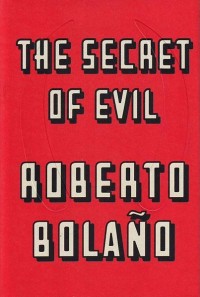 The Secret of Evil
The Secret of Evil
by Roberto Bolaño
New Directions, 2012
192 pages / $22.95 buy from Powell’s
Rating: 7.3
We now have a new book (in English) of Bolaño’s fiction, presumably one of his last (FSG is releasing the unfinished Woes of the True Policeman later this year, an extension of the Amalfitano section in 2666). The Secret of Evil is a collection of Bolaño’s fiction found on his computer after his death, comprised of many pieces that appear unfinished. As Ignacio Echevarría’s introduction notes, and as readers will already be familiar, Bolaño’s texts can tend toward inconclusiveness. The typical Bolaño ending culminates in anti-climax, things sort of petering out, trailing off indiscriminately, people boarding planes, looking down desolate streets, etc. So what’s interesting in these pieces is figuring out which are truly finished and which are still works in progress. READ MORE >
June 26th, 2012 / 12:06 pm
Stuff I Loved in 2011

That’s the feeling I look for, right? In whatever I’m eating, be it real food, or entertainment, art, people. The major event. A safe, manageable portion of the inner land or map blown away, torn out and away, dissolved or smoked. I only know a couple people who really seek that, or when they say they want that destruction it’s a good lie, and maybe they’ve said it enough so it’s shared and indistinguishable from truth. Regardless, it’s a common myth, a familiar dragon to chase, that of the Art That Changes For Good. I rarely recognize the mountain exploding in realtime, while reading something or watching a movie, it’s felt live that way maybe four times in my adultish life. Mostly it’s just feeling the echo of the boom a time later. Still, standing mountains aren’t terrible, and are often really nice. But sometimes you get lucky (pictured, pictured). Here’s what my year looked like:
Between Parentheses
 Between Parentheses
Between Parentheses
by Roberto Bolaño
New Directions, 2011
352 pages / $24.95 Buy from Powell’s
Rating: 9.0
“Reading, said Gil de Biedma, is more natural than writing. I would add (redundancy aside) that it’s also much healthier, no matter what ophthalmologists say. In fact, literature is a long struggle from redundancy to redundancy, until the final redundancy.”
– Roberto Bolaño
Between Parentheses
September 6th, 2011 / 12:30 pm
The American ____?
People love to make equivalencies. For instance, Stuart McLean is the Canadian Garrison Keillor, or The Agenda is the Canadian Charlie Rose.
Obviously, equivalencies are problematic. The Canadian anything seems to be paler version of the American thing. (Call me nationalistic.) That is, they aren’t really equivalent. And yet, there seems to be some value in these equivalencies, right? (Maybe I’m wrong.)
That being said: Is DFW the American Roberto Bolano?
Roberto Bolaño: “Instead of waiting, there is writing.”

“The truth is, I don’t believe all that much in writing. Starting with my own. Being a writer is pleasant—no, pleasant isn’t the word—it’s an activity that has its share of amusing moments, but I know of other things that are even more amusing, amusing in the same way that literature is for me. Holding up banks, for example. Or directing movies. Or being a gigolo. Or being a child again and playing on a more or less apocalyptic soccer team. Unfortunately, the child grows up, the bank robber is killed, the director runs out of money, the gigolo gets sick and then there’s no other choice but to write. For me, the word writing is the exact opposite of the word waiting. Instead of waiting, there is writing. Well, I’m probably wrong—it’s possible that writing is another form of waiting, of delaying things. I’d like to think otherwise.”
from interview in Bomb, 2002
2 STORIES
Wow, I just read the Bolaño story in the most recent New Yorker—it’s here, and it’s called “William Burns”–and I loved it. First anything by Bolaño that I’ve loved. I had very mixed feelings about 2666. But this was great. It kind of reminded me of a Ligotti story, with the degrees of distance from the narrator, the surreal dread, the shifting perceptions of the source of danger, and the dreamlike progression. It feels like transcribed dream, which is of particular interest to me at the moment.
Similarly, I’m loving I. Fontana’s “UB” at Spork, just as I loved the Jean Harlow story from a while back. I’m interested in anything Fontana writes these days; he knows what he’s doing.
February 3rd, 2010 / 7:28 pm

